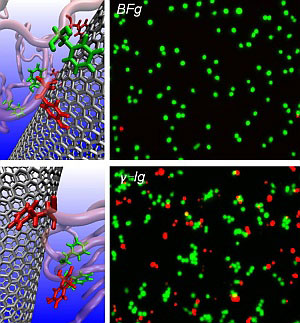| Dec 12, 2011 |
Detoxifying carbon nanotubes
|
|
(Nanowerk News) Carbon nanotubes (CNTs) are expected to revolutionize the development of various high-performance biomedical devices and materials. Their particular ability to cross membranes and enter cells under certain conditions can facilitate the delivery of therapeutics to specific targets in the body — but may also induce harmful side effects such as inflammation and abnormal tissue growth. Chunying Chen and colleagues from the Chinese Academy of Sciences in Beijing and Columbia University in the US have now developed a method for determining how interactions between blood proteins and CNTs affect nanotube toxicity ("Binding of blood proteins to carbon nanotubes reduces cytotoxicity").
|
|
"Our blood circulatory system will most likely be the first port exposed to CNTs and CNT-based nanoproducts upon contact with biomedical applications or direct inhalation," says Chen. She explains that the abundance of proteins that can associate with CNTs in the blood, combined with variations in distribution and binding affinity, leads to complex and dynamic nanoparticle–protein interactions.
|
 |
| Nanotubes coated with the blood proteins BFG and γ-Ig (left) and corresponding fluorescence images showing the live (green) and dead cells (red) exposed to the nanomaterials. (© 2011 National Academy of Sciences)
|
|
Other scientists have demonstrated that the biological properties of CNTs arise from interactions between proteins and the nanoparticle surface, and that these interactions depend on the surface characteristics, composition and synthesis of the nanotubes. However, the mechanism that drives the binding processes is unknown. Chen's team evaluated the adhesion of blood proteins to the nanotubes and the biological impact of this process through a combination of experiments and computer simulations. "Changes in nanoparticle absorption capacity and selective binding to serum proteins may help to understand cell trafficking, systemic translocation and the potential health risk of CNTs in the body," she says.
|
|
Using this approach, the researchers made the surprising discovery that different blood proteins competed to bind onto the CNT surface, with different adsorption capacities and packing arrangements. The experimental and computational results indicated that these behaviors originate from each protein's unique structure and the number of hydrophobic residues present in each protein. "In turn, the resulting protein-coated CNTs will exhibit different cytotoxicity by influencing subsequent cellular responses," says Chen.
|
|
The team is currently planning to extend the investigations on protein–nanoparticle interactions to other kinds of nanomaterials in order to design nontoxic biocompatible CNT applications and predict the fate and behavior of these materials in vivo.
|

